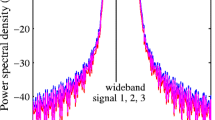Abstract
A new Direction of arrival (DOA) estimation method for wideband coherent sources is presented in this paper. This method does not require any prior knowledge of the source number and initial estimation of source angles. In the proposed method, at first, upon calculating the focusing matrix, the covariance matrix of all frequency bins are transformed to the reference frequency. Then by forming a Hankel matrix for each signal subspace eigenvector (SSE), the de-correlation process is formed and the linear independent vectors are extracted from the Singular Value Decomposition (SVD) approach. The simulation results in different conditions shows that the proposed algorithm has better performance compare to other algorithms.






Similar content being viewed by others
References
Tuncer, T. E., & Friedlander, B. (2009). Classical and modern direction-of-arrival estimation. Academic Press.
Amin, H., Bertrand, A., & Moonen, M. (2019). Cooperative integrated noise reduction and node-specific direction-of-arrival estimation in a fully connected wireless acoustic sensor network. Signal Processing, 107, 68–81.
Selva, J. (2018). Efficient wideband DOA estimation through function evaluation techniques. IEEE Transactions on Signal Processing, 66(12), 3112–3123.
Liu, Y., Liu, C., Zhao, Y., & Zhu, J. (2018). Wideband array self-calibration and DOA estimation under large position errors. Digital Signal Processing, 78, 250–258.
Kikuta, K., & Hirose, A. (2018). Direction-of-arrival estimation of ultra-wideband signals in narrowband interference environment based on power inversion and complex-valued neural networks. Neural Processing Letters, 47(3), 921–933.
Li, L., Younan, N. H., & Shi, X. (2019). Parameter estimation based on sigmoid transform in wideband bistatic MIMO radar system under impulsive noise environment. Sensors, 19(2), 232.
Schmidt, R., & Af, X. W. (1986). Multiple emitter location and signal parameter estimation. IEEE Transactions on Antennas and Propagation, AP-34(3), 276–280.
Roy, R., & Kailath, T. (1989). ESPRIT-estimation of signal parameters via rotational invariance techniques. IEEE Transactions on Acoustics, Speech, and Signal Processing, 37(7), 984–995.
Viberg, M., & Ottersten, B. (1991). Sensor array processing based on subspace fitting. IEEE Transactions on Signal Processing, 39(5), 1110–1121.
Stoica, P., Ottersten, B., Viberg, M., & Moses, R. L. (1996). Maximum likelihood array processing for stochastic coherent sources. IEEE Transactions on Signal Processing, 44(1), 96–105.
Wax, M., Shan, T., & Kailath, T. (1984). Spatio-temporal spectral analysis by eigenstructure methods. IEEE Transactions on Acoustics, Speech, and Signal Processing, 32(8), 817–827.
Molazadeh, A., Ghasimi, M., & Ardebilipour, M. (2019). A novel fast two stage method for wideband spectrum sensing. Physical Communication, 33, 172–177.
Hu, B., Li, X. J., & Chong, P. H. J. (2018) Denoised modified incoherent signal subspace method for DOA of coherent signals. In 2018 IEEE Asia-Pacific Conference on Antennas and Propagation (APCAP), pp. 539–540.
Wang, H., & Kaveh, M. (1985). Coherent signal-subspace processing for the detection and estimation of angles of arrival of multiple wideband sources. EEE Transactions on Acoustics, Speech, and Signal Processing, 33(4), 823–831.
Di Claudio, E. D., & Parisi, R. (2001). WAVES: Weighted average of signal subspaces for robust wideband direction finding. IEEE Transactions on Signal Processing, 49(10), 2179–2191.
Hung, H., & Kaveh, M. (1988). Focusing matrices for coherent signal-subspace processing. IEEE Transactions on Acoustics, Speech and Signal Processing, 36(8), 1272–1281.
El-Keyi, A., & Kirubarajan, T. (2008). Adaptive beamspace focusing for direction of arrival estimation of wideband signals. Signal Processing, 88(8), 2063–2077.
Cao, J., Liu, Z., & Xu, Y. (2008). New algorithm requiring no preprocessing for wideband DOA estimation. In Signal Processing, 2008. ICSP 2008. 9th International Conference on, pp. 394–397.
Kulhandjian, H., Kulhandjian, M., Kim, Y., & D’Amours, C. (2018). 2-D DOA estimation of coherent wideband signals with auxiliary-vector basis. In 2018 IEEE International Conference on Communications Workshops (ICC Workshops), pp. 1–6.
Yoon, Y., Kaplan, L. M., & Mcclellan, J. H. (2006). TOPS: New DOA estimator for wideband signals. IEEE Transactions on Signal Processing, 54(6), 1977–1989.
Hayashi, H., & Ohtsuki, T. (2016). DOA estimation for wideband signals based on weighted squared TOPS. EURASIP Journal on Wireless Communications and Networking, 2016(1), 243.
Yu, H., Liu, J., Huang, Z., Zhou, Y., & Xu, X. (2007). A new method for wideband DOA estimation. In Wireless Communications, Networking and Mobile Computing, 2007. WiCom 2007. International Conference on, pp. 598–601.
Ling, W., Jihao, Y., & Tianqi, C. (2008). New direction of arrival estimation method for wideband coherent signals. Journal of Systems Engineering and Electronics, 19(3), 473–478.
Zhang, J., Mao, Y. X., & Zhang, J. Y. (2013). New DOA estimation method for wideband coherent signals in the presence of correlated noise. Applied Mechanics and Materials, 263, 157–161.
Yamada, H., Shirai, S., & Yamaguchi, Y. (2014). Wideband DOA estimation technique for correlated sources. In Antennas and Propagation (ISAP), 2014 International Symposium on, pp. 27–28.
Cadzow, J. A. (1990). Multiple source location-the signal subspace approach. IEEE Transactions on Acoustics, Speech, and Signal Processing, 38(7), 1110–1125.
Totarong, P., & El-Jaroudi, A. (1993). Robust high-resolution direction-of-arrival estimation via signal eigenvector domain. IEEE Journal of Oceanic Engineering, 18(4), 491–499.
Hua, Y. (1992). Estimating two-dimensional frequencies by matrix enhancement and matrix pencil. IEEE Transactions on Signal Processing, 40(9), 2267–2280.
Yang, L., Jiao, Z., Kang, X., Song, G., & Suonan, J. (2016). Adaptive algorithm for estimating power frequency phasors using dynamic window length. IET Generation, Transmission & Distribution, 10(14), 3423–3430.
Shi-Wei, G., & Zheng, B. (1987). Data-based matrix decomposition technique for high-resolution array processing of coherent signals. Electronics Letters, 23(12), 643–645.
Xiang, Q., Cao, H., & So, H. C. (2016). Fast and accurate estimator for two-dimensional cisoids based on QR decomposition. Signal Processing, 120, 553–561.
Sellone, F. (2006). Robust auto-focusing wideband DOA estimation. Signal Processing, 86(1), 17–37.
Qian, C., Huang, L., Xiao, Y., & So, H.-C. (2015). Localization of coherent signals without source number knowledge in unknown spatially correlated Gaussian noise. Signal Processing, 111, 170–178.
Author information
Authors and Affiliations
Corresponding author
Additional information
Publisher's Note
Springer Nature remains neutral with regard to jurisdictional claims in published maps and institutional affiliations.
Rights and permissions
About this article
Cite this article
Fathtabar, A., Khazaei, A.A. & Ghezelbigloo, A. A New Eigen-Structure Based DOA Estimation Method for Wideband Coherent Signals. Wireless Pers Commun 117, 577–589 (2021). https://doi.org/10.1007/s11277-020-07884-0
Accepted:
Published:
Issue Date:
DOI: https://doi.org/10.1007/s11277-020-07884-0




